i
�
The Data Warehouse Lifecycle Toolkit
Table of Contents
- The Chess Pieces
- Introducing Data Warehouse Architecture
- Back Room Technical Architecture
- The Business Dimensional Lifecycle
- Project Planning and Management
- Collecting the Requirements
- A First Course on Dimensional Modeling
- A Graduate Course on Dimensional Modeling
- Building Dimensional Models
Chapter 1
Section 1 - Project Management and Requirements
Chapter 2
Chapter 3
Chapter 4
Section 2 - Data Design
Chapter 5
Chapter 6
Chapter 7
Section 3 - Architecture
Chapter 8
Chapter 9
Chapter 10 - Architecture for the Front Room
Chapter 11 - Infrastructure and Metadata
Chapter 12 - A Graduate Course on the Internet and Security
Chapter 13 - Creating the Architecture Plan and Selecting Products
Section 4 – Implementation
Chapter 14 - A Graduate Course on Aggregates
Chapter 15 - Completing the Physical Design
Chapter 16 - Data Staging
Chapter 17 - Building End User Applications
Section 5 - Deployment and Growth
Chapter 18 - Planning the Deployment
Chapter 19 - Maintaining and Growing the Data Warehouse
ii
�
The Purpose of Each Chapter
1.
The Chess Pieces. As of the writing of this book, a lot of vague terminology was
being tossed around in the data warehouse marketplace. Even the term data
warehouse has lost its precision. Some people are even trying to define the data
warehouse as a nonqueryable data resource! We are not foolish enough to think we
can settle all the terminology disputes in these pages, but within this book we will
stick to a very specific set of meanings. This chapter briefly defines all the important
terms used in data warehousing in a consistent way. Perhaps this is something like
studying all the chess pieces and what they can do before attempting to play a chess
game. We think we are pretty close to the mainstream with these definitions.
Section 1: Project Management and Requirements
2.
The Business Dimensional Lifecycle. We define
the complete Business
Dimensional Lifecycle from 50,000 feet. We briefly discuss each step and give
perspective on the lifecycle as a whole.
Project Planning and Management. In this chapter, we define the project and talk
about setting its scope within your environment. We talk extensively about the
various project roles and responsibilities. You won’t necessarily need a full headcount
equivalent for each of these roles, but you will need to fill them in almost any
imaginable project. This is a chapter for managers.
Collecting the Requirements. Collecting the business and data requirements is the
foundation of the entire data warehouse effort—or at least it should be. Collecting the
requirements is an art form, and it is one of the least natural activities for an IS
organization. We give you techniques to make this job easier and hope to impress
upon you the necessity of spending quality time on this step.
Section 2: Data Design
5.
A First Course on Dimensional Modeling. We start with an energetic argument for
the value of dimensional modeling. We want you to understand the depth of our
commitment to this approach. After performing hundreds of data warehouse designs
and installations over the last 15 years, we think this is the only approach you can
use to achieve the twin goals of understandability and performance. We then reveal
the central secret for combining multiple dimensional models together into a coherent
whole. This secret is called conformed dimensions and conformed facts. We call this
approach the Data Warehouse Bus Architecture. Your computer has a backbone,
called the computer bus, that everything connects to, and your data warehouse has a
backbone, called the data warehouse bus, that everything connects to. The
remainder of this chapter is a self-contained introduction to the science of
dimensional modeling for data warehouses. This introduction can be viewed as an
appendix to the full treatment of this subject in Ralph Kimball’s earlier book, The Data
Warehouse Toolkit.
6.
A Graduate Course on Dimensional Modeling. Here we collect all the hardest
dimensional modeling situations we can think of. Most of these examples come from
specific business situations, such as dealing with a monster customer list.
7.
Building Dimensional Models. In this chapter we tackle the issue of how to create
the right model within your organization. You start with a matrix of data marts and
dimensions, and then you design each fact table in each data mart according to the
techniques described in Chapter 5. The last half of this chapter describes the real-life
management issues in applying this methodology and building all the dimensional
models needed in each data mart.
3.
4.
Section 3: Architecture
8.
Introducing Data Warehouse Architecture. In this chapter we introduce all the
components of the technical architecture at a medium level of detail. This paints the
overall picture. The remaining five chapters in this section go into the specific areas
of detail. We divide the discussion into data architecture, application architecture, and
infrastructure. If you follow the Data Warehouse Bus Architecture we developed in
Chapter 5, you will be able to develop your data marts one at a time, and you will end
iii
�
up with a flexible, coherent overall data warehouse. But we didn’t say it would be
easy.
9.
Technical Back Room Architecture. We introduce you to the system components
in the back room: the source systems, the reporting instance, the data staging area,
the base level data warehouse, and the business process data marts. We tell you
what happened to the operational data store (ODS). We also talk about all the
services you must provide in the back room to get the data ready to load into your
data mart presentation server.
10.
Architecture for the Front Room. The front room is your publishing operation. You
make the data available and provide an array of tools for different user needs. We
give you a comprehensive view of the many requirements you must support in the
front room.
11.
Infrastructure and Metadata. Infrastructure is the glue that holds the data
warehouse together. This chapter covers the nuts and bolts. We deal with the detail
we think every data warehouse designer and manager need to know about
hardware, software, communications, and especially metadata.
12.
A Graduate Course on the Internet and Security. The Internet has a potentially
huge impact on the life of the data warehouse manager, but many data warehouse
managers are either not aware of the true impact of the Internet or they are avoiding
the issues. This chapter will expose you to the current state of the art on Internet-
based data warehouses and security issues and give you a list of immediate actions
to take to protect your installation. The examples throughout this chapter are slanted
toward the exposures and challenges faced by the data warehouse owner.
13.
Creating the Architecture Plan and Selecting Products. Now that you are a
software, hardware, and infrastructure expert, you are ready to commit to a specific
architecture plan for your organization and to choose specific products. We talk about
the selection process and which combination of product categories you need. Bear in
mind this book is not a platform for talking about specific vendors, however.
Section 4: Implementation
14.
A Graduate Course on Aggregations. Aggregations are prestored summaries that
you create to boost performance of your database systems. This chapter dives
deeply into the structure of aggregations, where you put them, how you use them,
and how you administer them. Aggregations are the single most cost-effective way to
boost performance in a large data warehouse system assuming that the rest of your
system is constructed according to the Data Warehouse Bus Architecture.
15.
Completing the Physical Design. Although we don’t know which DBMS and which
hardware architecture you will choose, there are a number of powerful ideas at this
level that you should understand. We talk about physical data structures, indexing
strategies, specialty databases for data warehousing, and RAID storage strategies.
16.
Data Staging. Once you have the major systems in place, the biggest and riskiest
step in the process is getting the data out of the legacy systems and loading into the
data mart DBMSs. The data staging area is the intermediate place where you bring
the legacy data in for cleaning and transforming. We have a lot of strong opinions
about what should and should not happen in the data staging area.
17.
Building End User Applications. After the data is finally loaded into the DBMS, we
still have to arrange for a soft landing on the users’ desktops. The end user
applications are all the query tools and report writers and data mining systems for
getting the data out of the DBMS and doing something useful. This chapter describes
the starter set of end user applications you need to provide as part of the initial data
mart implementation.
Section 5: Deployment and Growth
18.
Planning the Deployment. When everything is ready to go, you still have to roll the
system out and behave in many ways like a commercial software vendor. You need
to install the software, train the users, collect bug reports, solicit feedback, and
respond to new requirements. You need to plan carefully so that you can deliver
according to the expectations you have set.
iv
�
19.
Maintaining and Growing the Data Warehouse. Finally, when your entire data
mart edifice is up and running, you have to turn around to do it again! As we said
earlier, the data warehouse is more of a process than a project. This chapter is an
appropriate end for the book, if only because it leaves you with a valuable last
impression: You are never done.
Supporting Tools
•
Appendix A. This appendix summarizes the entire project plan for the Business
Dimensional Lifecycle in one place and in one format. All of the project tasks and roles
are listed.
•
Appendix B. This appendix is a guided tour of the contents of the CD-ROM. All of the
useful checklists, templates, and forms are listed. We also walk you through how to use
our sample design of a Data Warehouse Bus Architecture.
•
CD-ROM. The CD-ROM that accompanies the book contains a large number of actual
checklists, templates, and forms for you to use with your data warehouse development. It
also includes a sample design illustrating the Data Warehouse Bus Architecture
The Goals of a Data Warehouse
One of the most important assets of an organization is its information. This asset is
almost always kept by an organization in two forms: the operational systems of record
and the data warehouse. Crudely speaking, the operational systems of record are where
the data is put in, and the data warehouse is where we get the data out. In The Data
Warehouse Toolkit, we described this dichotomy at length. At the time of this writing, it is
no longer so necessary to convince the world that there are really two systems or that
there will always be two systems. It is now widely recognized that the data warehouse
has profoundly different needs, clients, structures, and rhythms than the operational
systems of record.
Ultimately, we need to put aside the details of implementation and modeling, and
remember what the fundamental goals of the data warehouse are. In our opinion, the
data warehouse:
•
•
•
Makes an organization’s information accessible. The contents of the data
warehouse are understandable and navigable, and the access is characterized by fast
performance. These requirements have no boundaries and no
limits.
Understandable means correctly labeled and obvious. Navigable means recognizing
your destination on the screen and getting there in one click. Fast performance means
zero wait time. Anything else is a compromise and therefore something that we must
improve.
fixed
Makes the organization’s information consistent. Information from one part of the
organization can be matched with information from another part of the organization. If
two measures of an organization have the same name, then they must mean the same
thing. Conversely, if two measures don’t mean the same thing, then they are labeled
differently. Consistent information means high-quality information. It means that all of
the information is accounted for and is complete. Anything else is a compromise and
therefore something that we must improve.
Is an adaptive and resilient source of information. The data warehouse is designed
for continuous change. When new questions are asked of the data warehouse, the
existing data and the technologies are not changed or disrupted. When new data is
added to the data warehouse, the existing data and the technologies are not changed
or disrupted. The design of the separate data marts that make up the data warehouse
must be distributed and incremental. Anything else is a compromise and therefore
something that we must improve.
•
Is a secure bastion that protects our information asset. The data warehouse not
only controls access to the data effectively, but gives its owners great visibility into the
uses and abuses of that data, even after it has left the data warehouse. Anything else
is a compromise and therefore something that we must improve.
v
�
•
Is the foundation for decision making. The data warehouse has the right data in it to
support decision making. There is only one true output from a data warehouse: the
decisions that are made after the data warehouse has presented its evidence. The
original label that predates the data warehouse is still the best description of what we are
trying to build: a decision support system.
The Goals of This Book
If we succeed with this book, you—the designers and managers of large data
warehouses—will achieve your goals more quickly. You will build effective data
warehouses that match well against the goals outlined in the preceding section, and you
will make fewer mistakes along the way. Hopefully, you will not reinvent the wheel and
discover “previously owned” truths.
We have tried to be as technical as this large subject allows, without getting waylaid by
vendor-specific details. Certainly, one of the interesting aspects of working in the data
warehouse marketplace is the breadth of knowledge needed to understand all of the data
warehouse responsibilities. We feel quite strongly that this wide perspective must be
maintained because of the continuously evolving nature of data warehousing. Even if
data warehousing leaves behind such bedrock notions as text and number data, or the
reliance on relational database technology, most of the principles of this book would
remain applicable, because the mission of a data warehouse team is to build a decision
support system in the most fundamental sense of the words.
We think that a moderate amount of structure and discipline helps a lot in building a large
and complex data warehouse. We want to transfer this structure and discipline to you
through this book. We want you to understand and anticipate the whole Business
Dimensional Lifecycle, and we want you to infuse your own organizations with this
perspective. In many ways, the data warehouse is an expression of information systems’
fundamental charter: to collect the organization’s information and make it useful.
The idea of a lifecycle suggests an endless process where data warehouses sprout and
flourish and eventually die, only to be replaced with new data warehouses that build on the
legacies of the previous generations. This book tries to capture that perspective and help
you get it started in your organization.
Visit the Companion Web Site
This book is necessarily a static snapshot of the data warehouse industry and the
methodologies we think are important. For a dynamic, up-to-date perspective on these
issues, please visit this book’s Web site at www.wiley.com/compbooks/kimball, or log on to
the mirror site at www.lifecycle-toolkit.com. We, the authors of this book, intend to maintain
this Web site personally and make it a useful resource for data warehouse professionals.
vi
�
1. 1
�
Overview
All of the authors of this book worked together at Metaphor Computer Systems over a
period that spanned more than ten years, from 1982 to 1994. Although the real value of
the Metaphor experience was the building of hundreds of data warehouses, there was an
ancillary benefit that we sometimes find useful. We are really conscious of metaphors.
How could we avoid metaphors, with a name like that?
A useful metaphor to get this book started is to think about studying the chess pieces
very carefully before trying to play the game of chess. You really need to learn the
shapes of the pieces and what they can do on the board. More subtly, you need to learn
the strategic significance of the pieces and how to wield them in order to win the game.
Certainly, with a data warehouse, as well as with chess, you need to think way ahead.
Your opponent is the ever-changing nature of the environment you are forced to work in.
You can’t avoid the changing user needs, the changing business conditions, the
changing nature of the data you are given to work with, and the changing technical
environment. So maybe the game of data warehousing is something like the game of
chess. At least it’s a pretty good metaphor.
If you intend to read this book, you need to read this chapter. We are fairly precise in this
book with our vocabulary, and you will get more out of this book if you know where we
stand. We begin by briefly defining the basic elements of the data warehouse. As we
remarked in the introduction, there is not universal agreement in the marketplace over
these definitions. But our use of these words is as close to mainstream practice as we
can make them. Here in this book, we will use these words precisely and consistently,
according to the definitions we provide in the next section.
We will then list the data warehouse processes you need to be concerned about. This list is
a declaration of the boundaries for your job. Perhaps the biggest insight into your
responsibilities as a data warehouse manager is that this list of data warehouse processes
is long and somewhat daunting
Basic Elements of the Data Warehouse
As you read through the definitions in this section, please refer to Figure 1.1. We will
move through Figure 1.1 roughly in left to right order.
Figure 1.1 The basic elements of the data warehouse.
Source System
An operational system of record whose function it is to capture the transactions of the
business. A source system is often called a “legacy system” in a mainframe environment.
The main priorities of the source system are uptime and availability. Queries against
source systems are narrow, “account-based” queries that are part of the normal
transaction flow and severely restricted in their demands on the legacy system. We
assume that the source systems maintain little historical data and that management
reporting from source systems is a burden on these systems. We make the strong
assumption that source systems are not queried in the broad and unexpected ways that
data warehouses are typically queried. We also assume that each source system is a
1. 2
�
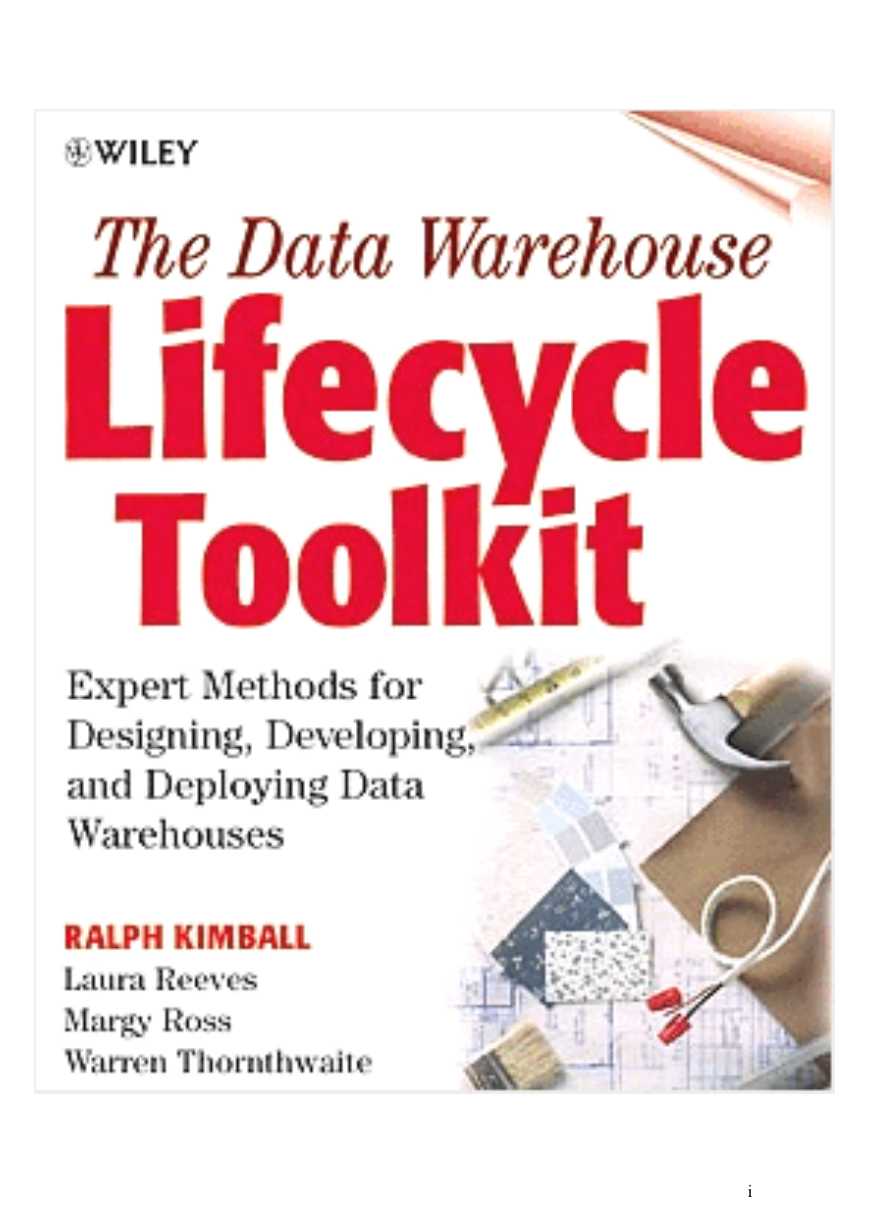
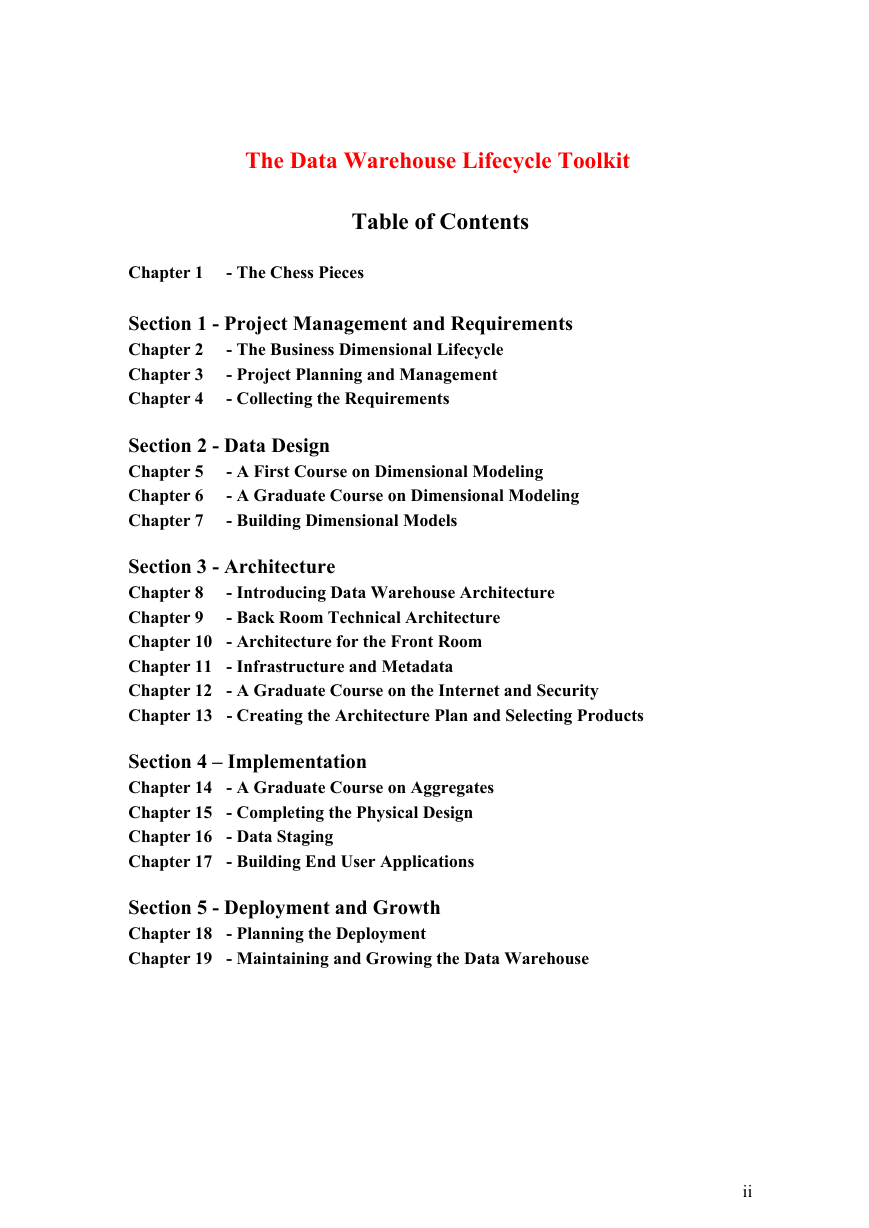
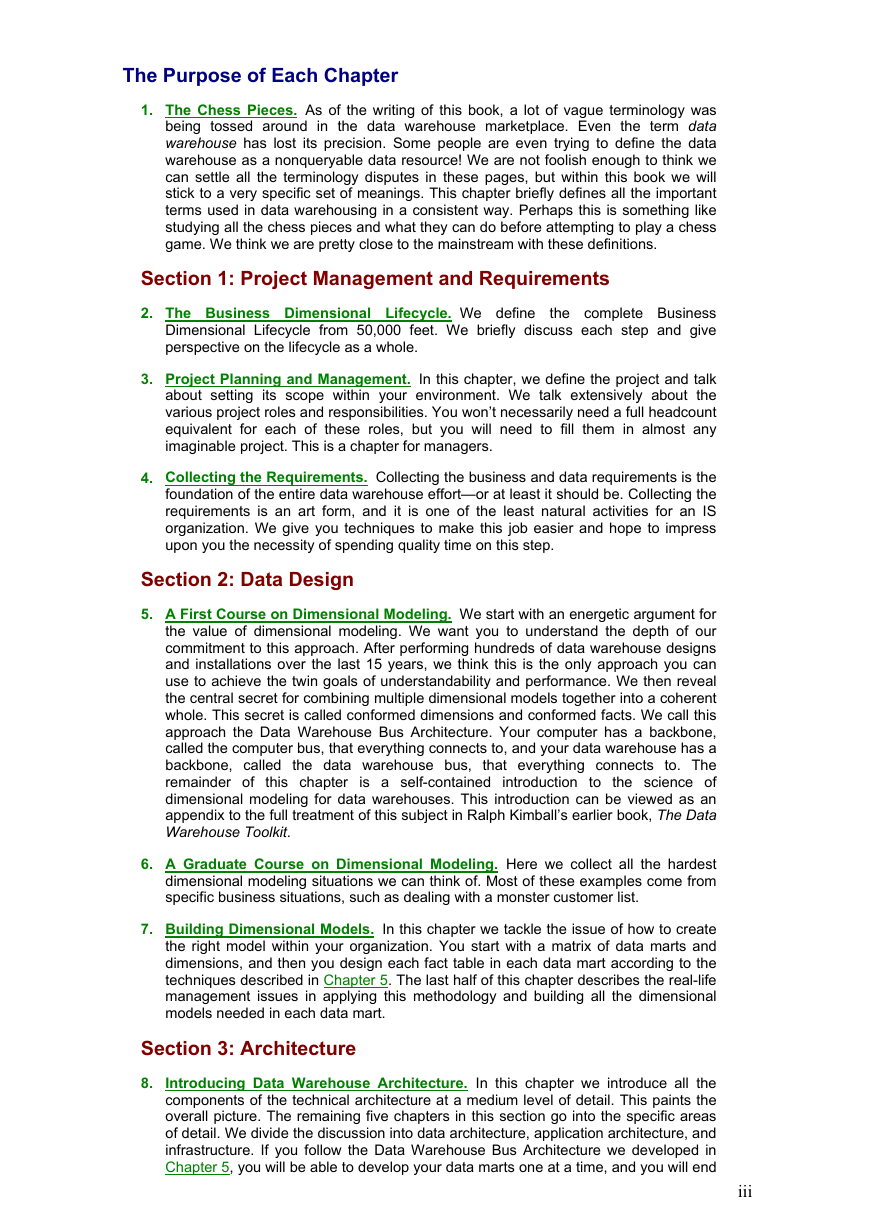
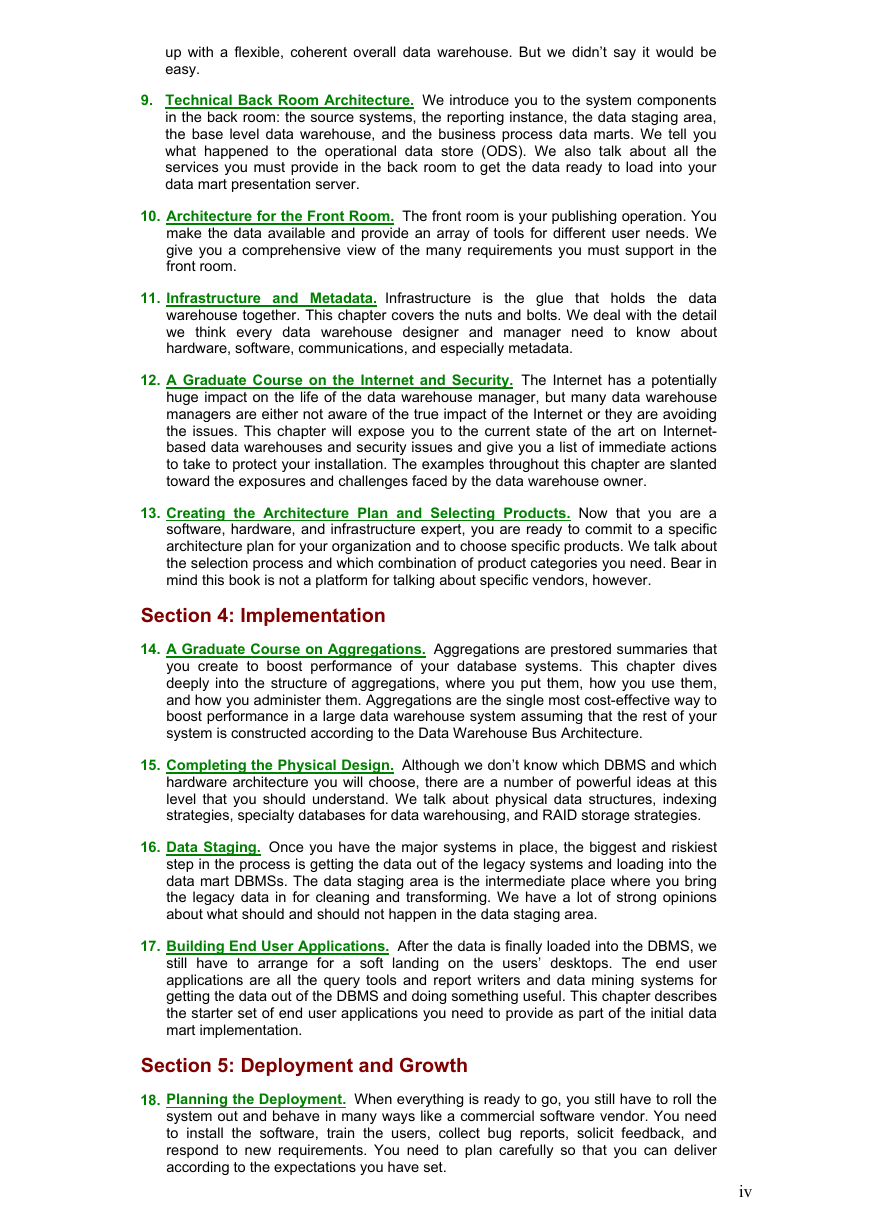
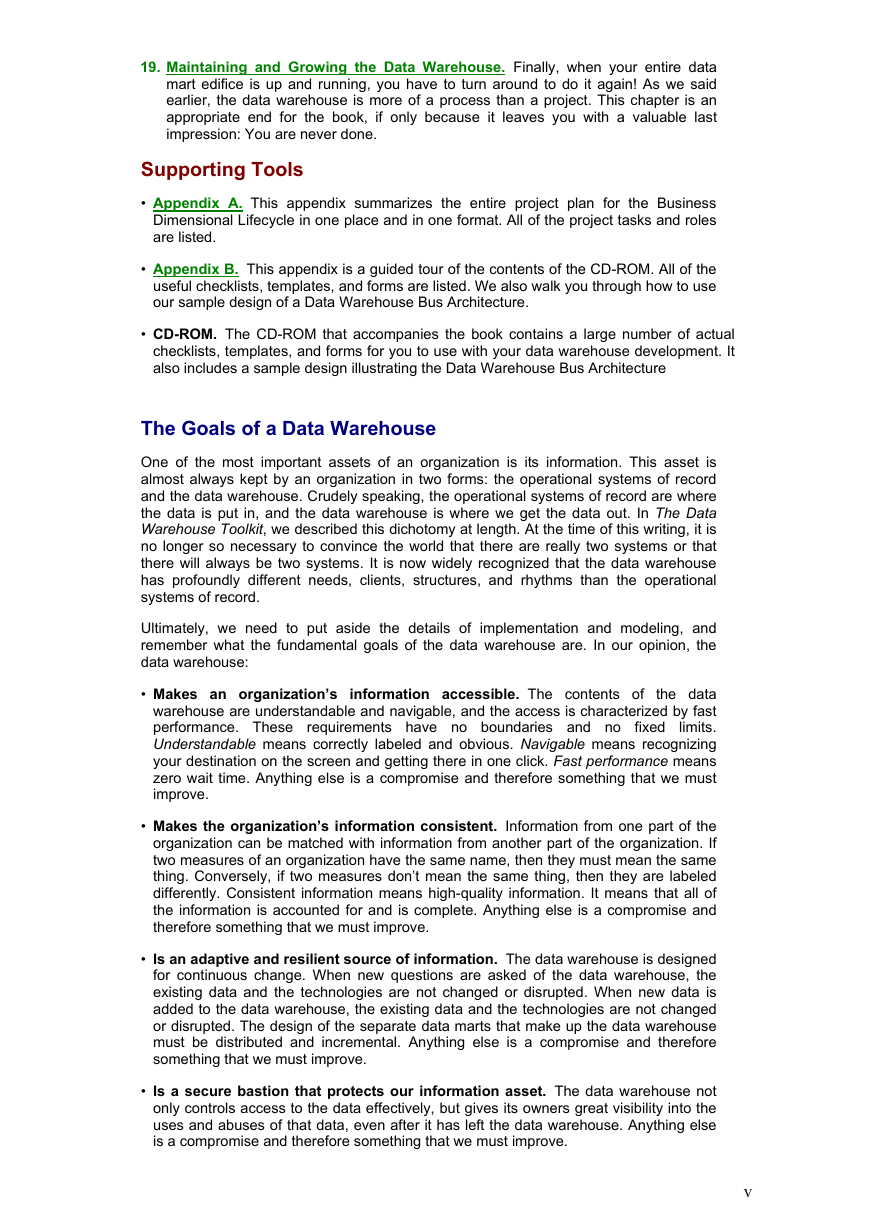
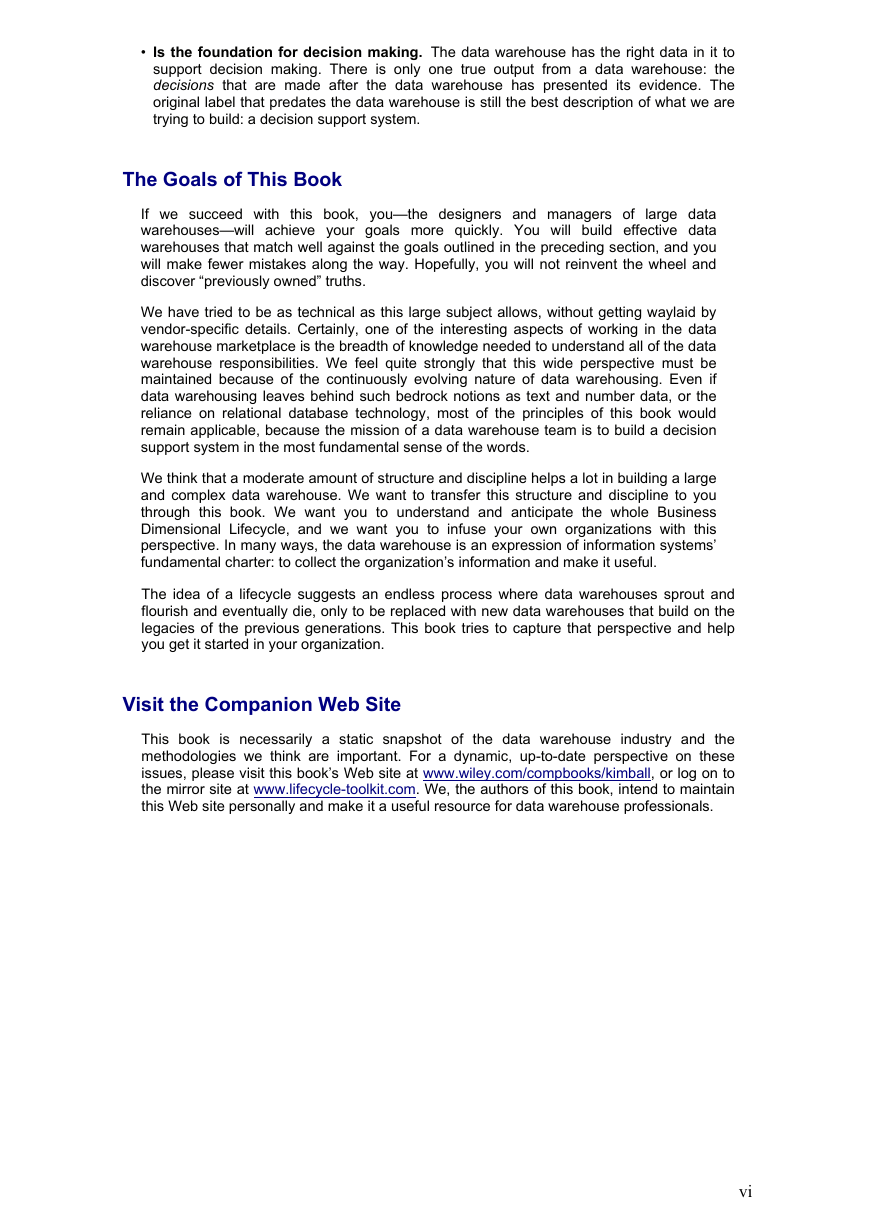

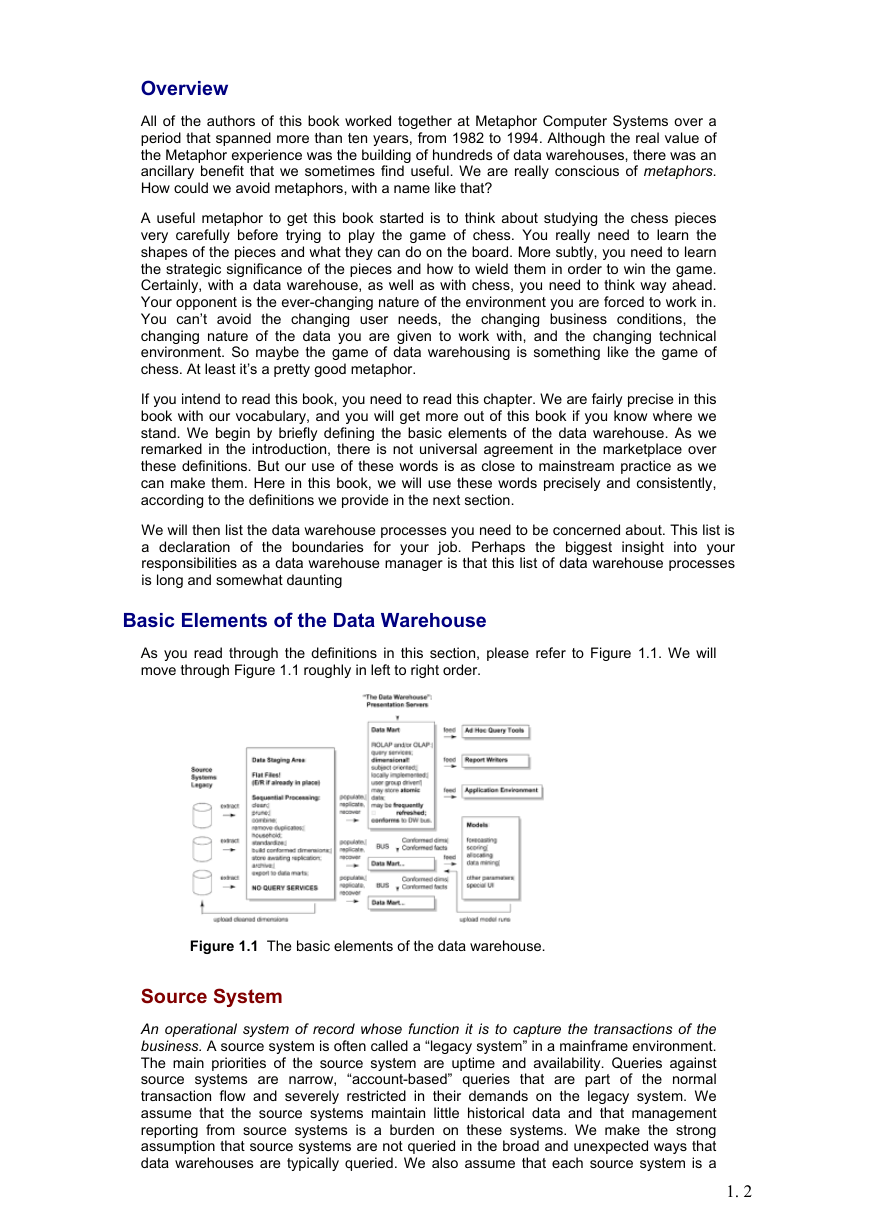








 2023年江西萍乡中考道德与法治真题及答案.doc
2023年江西萍乡中考道德与法治真题及答案.doc 2012年重庆南川中考生物真题及答案.doc
2012年重庆南川中考生物真题及答案.doc 2013年江西师范大学地理学综合及文艺理论基础考研真题.doc
2013年江西师范大学地理学综合及文艺理论基础考研真题.doc 2020年四川甘孜小升初语文真题及答案I卷.doc
2020年四川甘孜小升初语文真题及答案I卷.doc 2020年注册岩土工程师专业基础考试真题及答案.doc
2020年注册岩土工程师专业基础考试真题及答案.doc 2023-2024学年福建省厦门市九年级上学期数学月考试题及答案.doc
2023-2024学年福建省厦门市九年级上学期数学月考试题及答案.doc 2021-2022学年辽宁省沈阳市大东区九年级上学期语文期末试题及答案.doc
2021-2022学年辽宁省沈阳市大东区九年级上学期语文期末试题及答案.doc 2022-2023学年北京东城区初三第一学期物理期末试卷及答案.doc
2022-2023学年北京东城区初三第一学期物理期末试卷及答案.doc 2018上半年江西教师资格初中地理学科知识与教学能力真题及答案.doc
2018上半年江西教师资格初中地理学科知识与教学能力真题及答案.doc 2012年河北国家公务员申论考试真题及答案-省级.doc
2012年河北国家公务员申论考试真题及答案-省级.doc 2020-2021学年江苏省扬州市江都区邵樊片九年级上学期数学第一次质量检测试题及答案.doc
2020-2021学年江苏省扬州市江都区邵樊片九年级上学期数学第一次质量检测试题及答案.doc 2022下半年黑龙江教师资格证中学综合素质真题及答案.doc
2022下半年黑龙江教师资格证中学综合素质真题及答案.doc